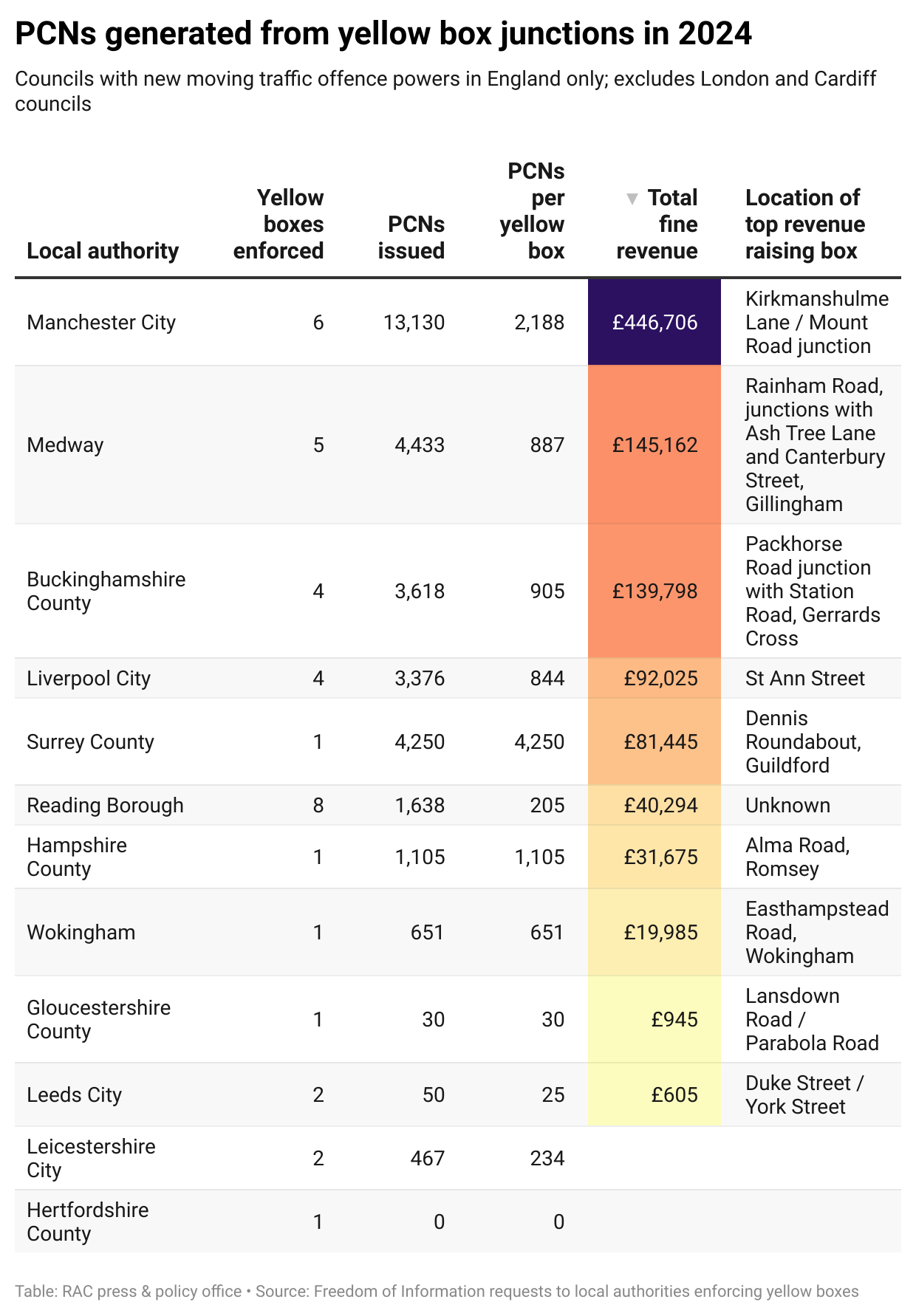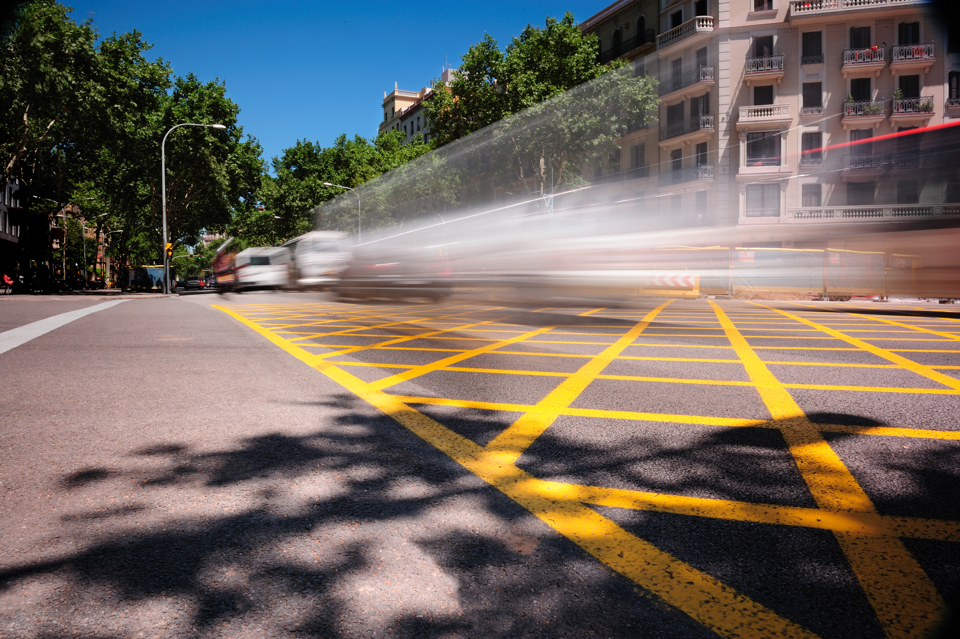Three councils outside London and Cardiff were responsible for issuing six-in-10 yellow box junction fines last year, according to new analysis from the RAC.
It found that drivers in 10 local authority areas newly enforcing yellow box junctions paid fines worth almost £1 million combined last year, after falling foul of the rules governing them.
The Government announced three years ago that it would let councils outside London and Cardiff, rather than the police, enforce against moving traffic offences.
Up until May 2022, only these two councils could enforce yellow box junctions and other moving traffic contraventions, such as driving the wrong way up a one-way street.
Freedom of information (FOI) requests sent to other councils in England that had applied for the powers since this time show that as of the start of this year, 36 separate boxes outside the two capital cities were being enforced – with a total of 32,748 penalty charge notices (PCNs) being issued to drivers stopping in them in 2024.
PCNs are generally £70, reduced to £35 if paid within 21 days of the notice being issued.
The RAC’s analysis found wildly varying numbers of PCNs being handed out in different council areas, with one authority bringing in almost half (49%) of all yellow box revenue outside London and Cardiff.
Manchester City Council, which is enforcing six yellow boxes, issued 13,130 PCNs for infringements last year – the equivalent of 36 a day – leading to £446,706 in fine revenue.
Second in terms of revenue from yellow box fines was Medway Council in Kent, which issued 4,433 PCNs last year for the five yellow boxes it enforced – the equivalent of 13 a day – raising £145,162.
Buckinghamshire County Council came third, issuing 3,618 PCNs from four yellow boxes. This was equivalent to 10 a day, raising £139,798.
These three councils alone issued more than six-in-10 of all yellow box PCNs outside London and Cardiff last year (21,181 PCNs, 65% of the total), accounting for almost three-quarters (73%) of the total fine income (£731,666 of £998,640).
RAC senior policy officer Rod Dennis said: “The large number of penalties being dished out over a small number of locations and in a short space of time should send alarm bells ringing in council offices.”
The data shows that not every council now enforcing yellow boxes is generating a huge amount of money from fines.
In fact, Dennis said that a small number of fines – and a small number of appeals – indicates a yellow box that’s working as it should.
“This should be the ambition behind any yellow box that a council is looking to start enforcing, rather than being seen as a revenue-raising opportunity,” he added.
“Yellow boxes serve an important purpose in keeping traffic flowing at busy junctions. But with councils outside London and Cardiff enforcing them for the first time, it’s now more important than ever they do everything they can to ensure drivers don’t get unfairly caught out.”

The highest PCN income from a single yellow box, however, was in Surrey where the Dennis Roundabout in Guildford saw 4,250 PCNs issued to drivers over a seven-month period, with drivers paying £81,445 in fines.
The fact so few councils account for so many yellow box fines suggests there may be issues with the design or location of the boxes themselves – something which the RAC has warned about previously.
This is a point supported by the fact that while data shows few fines are appealed by drivers, the proportion of these appeals that are upheld can be as high as 87% in the case of Medway Council (615 of 710 appeals upheld).
What’s more, several councils are issuing comparatively tiny numbers of PCNs compared to others, suggesting yellow boxes in these places are working well and are easy for drivers to negotiate.
Gloucestershire City Council issued just 30 between May and December 2024, with drivers in total fined only £945 from a single yellow box.
Leeds City Council handed out 50 PCNs in four months to the end of 2024, raising £605 from two enforced yellow box junctions.
The Highway Code states drivers must not enter yellow boxes unless they can get through them without stopping; the only exception is if they are waiting to turn right but are prevented from doing so by oncoming traffic.
The RAC has, however, previously uncovered problems with as many as nine-in-10 yellow boxes that councils were seeking to enforce.
Issues included drivers not being able to see where boxes end, boxes being larger than they need to be and ones extending beyond T-junctions.
During the first six months of enforcing a yellow box, statutory guidance for councils states they should issue warning notices to drivers caught infringing the box for the first time, with penalty charge notices issued after.
Dennis said: “It’s vital box junctions are used in the correct places and are only as big as absolutely necessary.
“They must be fairly set up so that drivers don’t find themselves stranded through no fault of their own.
“Sadly, we are aware of several locations where this isn’t the case.”
He continued: “We’ve previously expressed concern that drivers would get fined unnecessarily without the Government updating its box junction design guidance.
“This must clearly set out the locations where they can be used and, crucially, ensure they are sized correctly so as not to trap drivers unwittingly.
“With more local authorities likely to enforce yellow boxes in the coming months and years, it’s vitally important this happens.”






















Login to comment
Comments
No comments have been made yet.